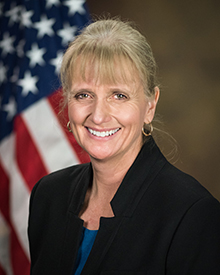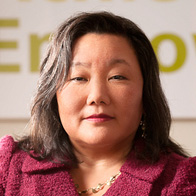Since President Donald Trump appointed her to head the Office of Juvenile Justice and Delinquency Prevention, Administrator Caren Harp has begun reshaping the office with a goal in mind: deregulation.
 Now she has overhauled the organizational structure of the OJJDP. Several divisions are gone and new ones have been created. That has worried advocates and juvenile justice practitioners who see it as an effort to gut the office of its power and scope.
Now she has overhauled the organizational structure of the OJJDP. Several divisions are gone and new ones have been created. That has worried advocates and juvenile justice practitioners who see it as an effort to gut the office of its power and scope.
The divisions of Juvenile Justice System Improvement, State and Community Development and Youth Development, Prevention, and Safety have all been shut down.

OJJDP
Caren Harp
“We want OJJDP to be as big, as strong and as helpful to the states as possible,” said Sarah Bryer, the executive director of the National Juvenile Justice Network. “It’s held states to a very hard standard. It’s pushed the bar. So, when we see divisions being shut down or being transferred to other agencies, it makes it appear that OJJDP is taking a less central role.
“This is not a good sign for OJJDP nor is this healthy development for young people in this country,” she said. “OJJDP seems to be eating itself.”
Harp said the goals of the office are unchanged, and that only some of the ways to achieve them has shifted.
“The Office of Juvenile Justice and Delinquency Prevention envisions a nation where our children are free from crime and violence. If they come into contact with the justice system, the contact should be both just and beneficial to them,” an office spokesman told JJIE in an email.
Also, the research duties of the OJJDP’s Innovation and Research Division were transferred to the National Institute of Justice.
Shift in research

Jeffrey Butts
Jeffrey Butts, director of the John Jay College of Criminal Justice Research and Evaluation Center, said such a move risks effectively freezing research in the field.
“If NIJ was an actual science agency, shutting down the research division of OJJDP and moving it to NIJ would not cause objection,” he said, “but if that’s not true, then shutting down the research division of OJJDP effectively eliminates federal support for research on juvenile justice and that’s a huge problem.”
Butts, who has worked in conjunction with OJJDP since the late 1980s, said restructuring in an agency as small as OJJDP is normal business for every new administration.
“OJJDP has never been large enough to justify the existence of many, many different divisions,” Butts said. “So it’s not necessarily a problem that the number of separate divisions was reduced. The real question is, what is the work being done? And do these changes reflect a shift in funding, a shift of policy emphasis? And I don’t know if you know enough yet to know whether that’s true.”
But the closing of divisions such as Juvenile Justice System Improvement ― which was a point of contact for a constellation of advocates and social workers who provided input — has left many of them perplexed and worried.
New divisions created have exacerbated concerns, such as the Special Victims and Violent Offenders Division, which some advocates say will emphasize punishment.
“This is a statement of how OJJDP leadership wants the country to see youth who are system involved,” said Sara Kugler, director of advocacy and communication at National Crittenton, an advocacy group for young women. “This is OJJDP leadership naming an issue to create an issue to justify a punitive approach by suggesting violent crime among youth is a prevailing issue. It's not.”
The reorganization of the office, coming after changes made to the mission statement on the office website and the takedown of guidance given to the states to assess disproportionate minority contact (DMC), shows that OJJDP is moving in the opposite direction of the field, she said.
“The field, inclusive of states and local jurisdictions, is working to reduce the use of incarceration and invest in community-based services and supports for youth — reflecting that incarceration is expensive, inefficient and harmful for young people,” Kugler said. “But OJJDP seems to be doubling down on an outdated, punitive approach.”
‘Systems are OK’?

Jeannette Pai-Espinosa
Jeannette Pai-Espinosa, president of National Crittenton, said a division dealing directly with violent crime has little justification since the majority of youths, female in particular, aren’t in the justice system for violent crimes.
Increasing efficiency and reducing duplications are normal procedures for an agency, she said, but the removal of the Juvenile Justice System Improvement Division “really seems to imply that the systems are OK, it’s the kids that are the problem.”
On multiple occasions, Harp made clear her office is going to loosen up some of the burden the federal government has on the states in addressing juvenile justice issues, her rationale being too much regulation has crippled the states’ ability to tackle them.
She also signaled her dissatisfaction in the existing strategy used to address the overrepresentation of minorities in the juvenile justice system and her will to move to an “outcome-based” approach.
“It is imperative that we shift from our current approach to one that better serves youth. If we are truly committed to reducing DMC, we cannot continue to simply distribute money and hope for a different result. It’s time to try something new,” she wrote in a June JJIE op-ed.
Some of Harp’s critics charge the tone-deaf approach to equity shown by the Trump administration is cascading down to OJJDP, and shaping the way the office handles racial bias within the juvenile justice system.
At a recent Chicago rally, Trump himself praised the police practice of stop-and-frisk as an effective tool. Stop-and-frisk tactics were found unconstitutional by a federal judge in 2013, after studies showed that they disproportionately targeted minorities.
Social workers and advocates in the juvenile justice field fear Harp will choose the same strong-arm approach.
Time will tell

Judge Steven Teske
But people who work closely with Harp, such as Judge Steven Teske, the national chair of the executive board of The Coalition for Juvenile Justice and a member of Harp’s “listening group,” said such charges are a misrepresentation.
“She hasn’t done this by herself. She’s not making decisions in a vacuum,” he said.
It will take some time before the redesign of the OJJDP has any tangible effect. Practitioners in juvenile justice are unable to say how the structural changes will play out.
“It’s still relatively new. With any new changes, it takes time for these changes to come to fruition,” said Michael Pennington, a 25-year veteran of the justice system in Pennsylvania, where he is director of the Pennsylvania Commission on Crime and Delinquency’s Office of Juvenile Justice and Delinquency Prevention.
Pennington, who has worked with OJJDP across three administrations, is one of the experts advising Harp on data collection for youth who come in contact with the justice system.
Over the last several years, he said, lack of funds and over-regulation prevented states from being able to comply with some of the Juvenile Justice and Delinquency Prevention Act core protections, in particular the monitoring of disproportionate minority contact within the system.
So when Harp came along, he and other practitioners around the country saw an opportunity to modify some of the ways OJJDP operated to make it more efficient, and make it easier for states to maintain compliance.
Simplification
One such change — and also one that caused the biggest controversy, according to several advocates — was to reduce the number of data collection points in the justice process used to measure DMC from nine to five. Each state is now required to monitor only four.
“What we talked about was, is there any way to simplify the process? To really monitor more the highest-risk areas as opposed to things that may be low-risk,” Pennington said.
Another recommendation he made to Harp was to simplify the grant application process for states and to increase staffing to assist them.
The OJJDP spokesman confirmed that “the newly reorganized Office significantly increases the number of staff who provide oversight and technical assistance to states and territories awarded Title II funding under the JJDP Act.”
Pennington said the boosted assistance to states will mean better and more training for personnel in charge of monitoring compliance with the core requirements of the law.
While the new language used by the OJJDP does reflect the administration’s language, OJJDP has not changed its goals, as some of Harp’s critics have suggested, he said.
“It’s a shift in the approach, not a shift in the priorities,” Pennington said.
Racial bias worries
In her presentation at a juvenile justice conference in Washington, D.C., last June, Harp raised eyebrows among the juvenile justice workers present because one of her slides read, “We are committed to reducing DMC while maintaining public safety.”
She was asked to explain why she drew such an explicit connection between safety and minority youth. She said what she meant was that the administration will not pull any punches in its effort to curb juvenile crime.
But if the OJJDP priority is to be tough on crime without addressing the racial bias at the various stages of the justice system, minority youth will continue to be arrested and processed disproportionately more than their nonminority counterparts, critics say.
Joshua Rovner, a senior associate at The Sentencing Project, an advocacy group, said he was unsettled by Harp’s words, which he says echoes the rhetoric of Trump and Justice Department Attorney General Jeff Sessions.
“This office seems to be interested in punishing young people,” he said.
Since her June presentation, some juvenile justice reform advocates have begun viewing Harp with increasing mistrust, claiming she’s on a solo mission to gut the office she runs.
‘Nonprofits misinformed’
Teske, describing himself as one of the most outspoken and controversial judges in the country in the field of juvenile justice, said he appreciates the work done by nonprofits, but that their criticism is often misinformed.
“These nonprofits and advocates aren’t in my shoes,” he said. “They’re not distributing those federal monies. They don’t have to deal with that stuff. They don’t know. They can complain all they want, but they’re not gonna lose money.
“All these folks are criticizing Caren Harp because she’s reducing the number of data decision points from nine to five. No one’s asking the question whether the four she’s getting rid of are really all that necessary,” Teske said.
He is a proponent of the view that OJJDP has burdened states with excessive over-regulation, which has yielded poor results, particularly on DMC. He said states have been “spinning the wheel” collecting data and being monitored, depleting resources that could be used to find new ways to address racial and ethnic disparity in ways that fits each state’s situation.
“The states are doing a pretty damn good job, if you just let them,” Teske said. “Today, we need to come up with solutions on a state-by-state basis that will address DMC according to the issues confronting each state. That’s what Caren Harp is trying to do.”


Working on DMC issues locally and statewide, reducing the juvenile justice system contact points from nine to five sets DMC back decades. Mr. Pennington’s and Judge Teske’s statements are opinions not objective analyses of national or other state’s data. OJJDP’s DMC National Databook provides a decent snapshot of national data. Mr. Pennington and Judge Teske should also know that OJJDP’s DMC Reduction Model is empirically based. If states follow it they should see reductions. I’ve worked in a jurisdiction that saw measurable reductions over a three year period featured in OJJDP’s Case Studies of Nine Jurisdictions that Reduced Disproportionate Minority Contact in their Juvenile Justice Systems (https://www.ncjrs.gov/pdffiles1/ojjdp/grants/250301.pdf). As a local and state juvenile justice stakeholder, I was honored to be apart of this study. As former House Speaker Tip O’Neil famously said “All politics is local”, which also applies to DMC. It appears Mr. Pennington’s and Judge Teske’s political beliefs are influencing their comments instead of what the data and research show. Reducing “burdensome” requirements are parroted talking points of this administration which is probably the reason why they regularly advise Ms. Harp. The irony is that Pennsylvania is also featured in OJJDP’s study so I would advise Mr. Pennington to read it.
Further, some states are weary with OJJDP’s constant reorganizations and policy changes. While change is expected when a new Administrator is appoinited, it appears a small group of people who gain access have an inordinate amount of influence rarely based on the JJDP Act, longstanding policy guidance, and what actually works. If OJJDP, Mr. Pennington, and Judge Teske are really interested in DMC reduction and not their own beliefs, they would actually review data and research, meaningfully consult all the
states and territories, including youth, and advocate best practices.